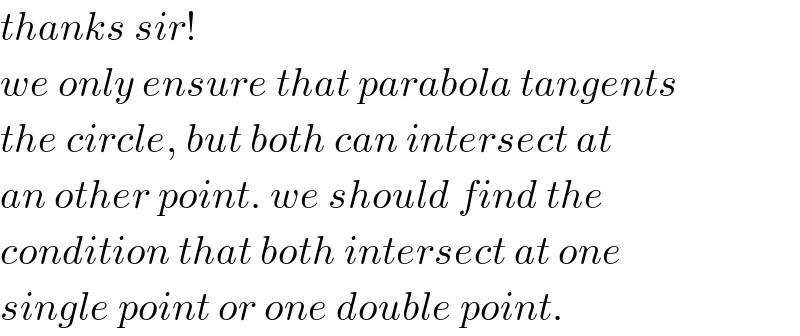
Question and Answers Forum
Question Number 72721 by mr W last updated on 01/Nov/19

Commented by mr W last updated on 01/Nov/19

Commented by kaivan.ahmadi last updated on 01/Nov/19

Commented by mr W last updated on 01/Nov/19

Commented by mr W last updated on 01/Nov/19

Commented by kaivan.ahmadi last updated on 01/Nov/19

Commented by ajfour last updated on 01/Nov/19

Commented by ajfour last updated on 02/Nov/19

Commented by mr W last updated on 02/Nov/19

Commented by MJS last updated on 02/Nov/19

Commented by MJS last updated on 02/Nov/19
I once posted this, it might help here. But I'm afraid we cannot generally solve.
Commented by ajfour last updated on 02/Nov/19
thanks for sharing it again, mjs sir, but herein by simply imposing D<0 would suffice for the matter is that of a cubic and not quartic, i guess.
Commented by mr W last updated on 02/Nov/19

Answered by mr W last updated on 02/Nov/19

Commented by mr W last updated on 02/Nov/19
![we may have two cases: case 1: parabola touches the circle at two points case 2: parabola touches the circle only at one point case 1: y=Ax+Bx^2 =B[x^2 +(A/B)x+((A/(2B)))^2 ]−(A^2 /(4B)) y=B(x+(A/(2B)))^2 −(A^2 /(4B)) ⇒(A/(2B))=−d y=B(x−d)^2 −Bd^2 =B(x^2 −2dx) y′=2B(x−d) point B(d−R sin ϕ, R(1+cos ϕ)) tan ϕ=2B(d−R sin ϕ−d) ⇒B=−(1/(2R cos ϕ)) R(1+cos ϕ)=B(d−R sin ϕ−2d)(d−R sin ϕ) R(1+cos ϕ)=((d^2 −R^2 sin^2 ϕ)/(2R cos ϕ)) 1+cos ϕ=((δ^2 −sin^2 ϕ)/(2 cos ϕ)) with δ=(d/R) (cos ϕ+1)^2 =δ^2 ⇒cos ϕ=δ−1 ⇒B=−(1/(2R(δ−1))) i.e. we have case 1 if 1<δ≤2. in this case the eqn. of parabola is y=−((x(x−2d))/(2R(δ−1))) or A=−(δ/(δ−1)), B=−(1/(2R(δ−1))) case 2: y=Ax+Bx^2 y′=A+2Bx point B(d−R sin ϕ, R(1+cos ϕ)) tan ϕ=A+2B(d−R sin ϕ) ...(i) R(1+cos ϕ)=(d−R sin ϕ)[A+B(d−R sin ϕ)] ((R(1+cos ϕ))/((d−R sin ϕ)))=A+B(d−R sin ϕ) ...(ii) (i)−(ii): ⇒B′=BR=(((δ−sin ϕ)tan ϕ−(1+cos ϕ))/((δ−sin ϕ)^2 )) 2(ii)−(i): ⇒A=((2(1+cos ϕ)−(δ−sin ϕ)tan ϕ)/(δ−sin ϕ))](Q72761.png)
Commented by ajfour last updated on 02/Nov/19

Commented by mr W last updated on 02/Nov/19

Commented by mr W last updated on 02/Nov/19

Commented by ajfour last updated on 02/Nov/19

